The most common obstacle to maintain a calorie deficit is the constant appetite and hunger pangs. But fortunately for you, I prepare an extensive list of foods (and activities) that can lower your cravings and make hunger disappear. This way you can get an unfair advantage and speed up the process.
I’ve also done the little experiment and surveyed a group of people who are successfully lost a lot of weight and asked them about their best tips for keeping the hunger at bay.
By the end of this article you will know all the best foods for calorie deficit and have better undertanding of what influence hunger and satiety.
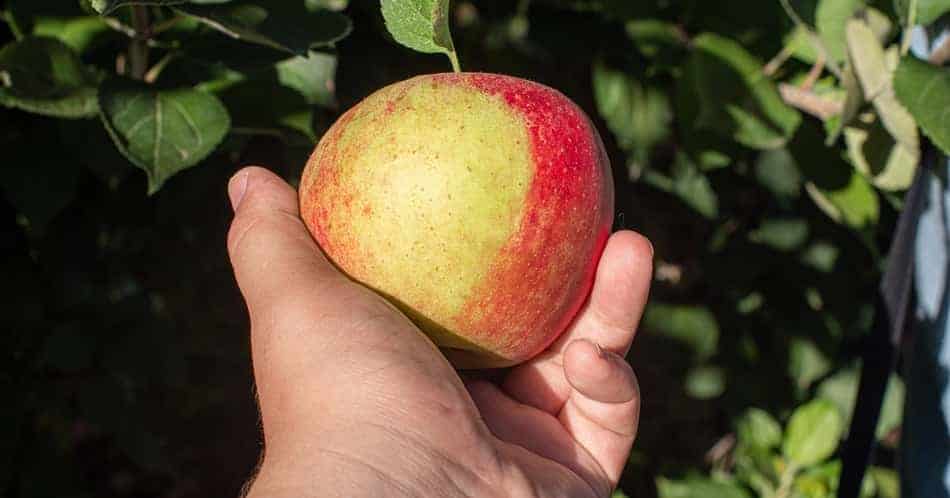
1. Plan To Add Some Potatoes To Your Diet
The most important thing during a calorie deficit is control of satiety. And potatoes are the king of satiety. A lot of people avoid adding potatoes while being in the calorie deficit because of high carbohydrates content. However, a number of experts confirm that potatoes are in fact of the most filling foods.
A number of research publications confirm that indeed, potatoes are the most filling foods. On the satiety index, potatoes are at the top with a 323% satiety score.
Comparing to white bread (100%), white potatoes are 3x more filling than bread, despite being high in carbs.
This means when you consume potatoes on a daily basis, they will lower your hunger throughout the day. Some people say that this isn’t satiety, but more of boredom.
Apart from keeping you away from cravings, potatoes also are:
- Gluten-free
- High on potassium (more than a regular banana)
- Sources of vitamin C
- Sources of vitamin B6
A fascinating study done by Jennifer J. Lee from Ryerson University in Toronto divided 21 people into 5 categories:
| Mashed potatoes | 450 kcal |
| French fries | 450 kcal |
| White beans with egg omelet | 450 kcal |
| Cereal, milk, and bread | 450 kcal |
| Intermittent fasting | – |
And they compared average appetite scores for each of the meals.
The results showed that groups who consumed mashed potatoes felt fuller and ate less on the following meal, which was comparable to the intermittent fasting group.
2. Eat Popcorn As A Filling Snack To Combat Evening Cravings
Popcorn is a great snack that not only fills you up quickly but also delivers relatively low calories. One cup of air-popped popcorn provides about 30 calories, and to reach 100 grams of carbs you would need to eat 20 cups.
On the satiety score, popcorn ranks at 153% and it’s more filling than foods like lentils, peanuts, corn flakes, and even all-bran.
A great study done by Von Nguyen from Rippe Lifestyle Institute in Florida, compared satiety and fullness from two common snack foods using the analogue scales 30 minutes after eating:
- low-fat popcorn
- potato chips
In total the groups was divided into three categories
| 1 cup popcorn | 15 kcal |
| 6 cups popcorn | 100 kcal |
| 1 cup potato chips | 150 kcal |
After each group ate their snacks, everyone was invited into the post-snack meal (source). The key takeaways from the study show that:
- Popcorn had a bigger effect on satiety than potato chips
- Researchers suggest that whole grain popcorn is the best choice to reduce hunger and lower energy intake
That being said you can substitute popcorn as your go-to snack, but you need to be careful of extra fat content.
3. Choose Whole Orange, Not The Orange Juice
Whole oranges have more satiating power than orange juice. In general, drinking orange juice is considered healthy. However, during the processing, all the soluble and insoluble fiber is stripped off the orange and all its left is liquid with calories (and nutrients).
That’s why having a whole orange is a much better choice, especially while dieting.
In a study done by Franziska A Hägele from the Institute of Human Nutrition and Food Sciences in Germany, 26 healthy adults divided into two groups (source).
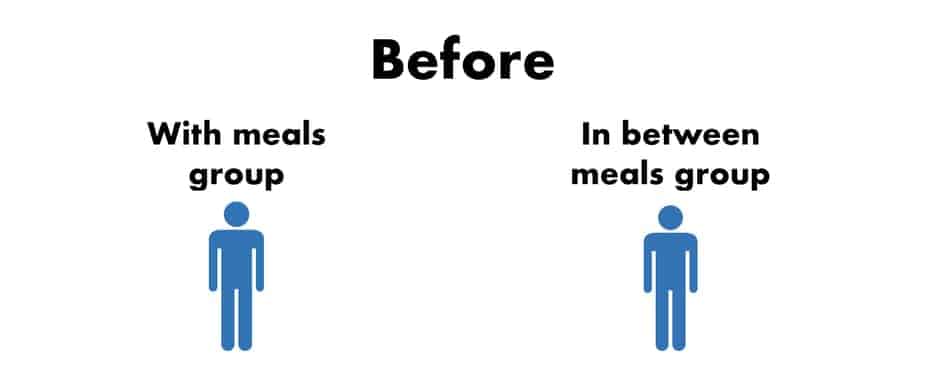
- Group A drink orange juice together with meals
- Group B drink orange juice in-between meals
Researchers checked how did that small change could have a potential impact on the participants. Because you can think that just by having 3 glasses of orange juice, nothing wrong is gonna happen, right?
Not quite.
After 4 weeks, group A who drink orange juice together with meals lost 0.3 kg of body fat and improved their overall lipid profiles. On the other hand, group B gained, on average, 1 kg of body fat just from drinking orange juice alone.
Group B also seems to increased total calorie intake, comparing to group B.
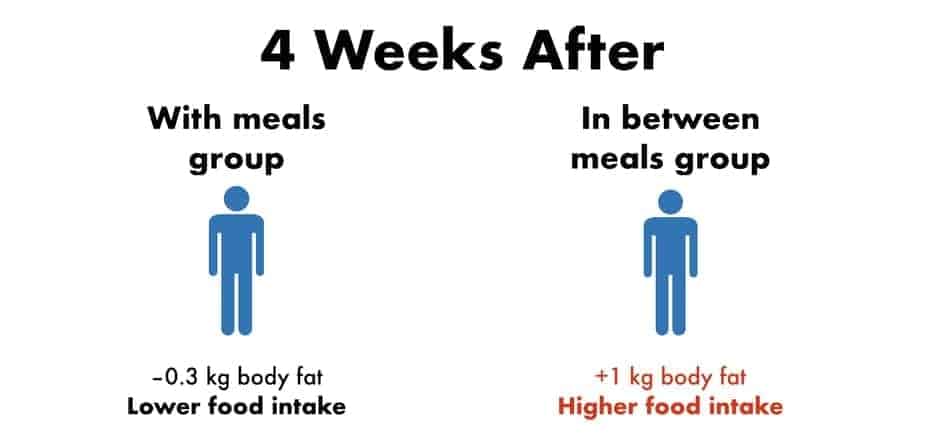
This little experiment shows us that removing fiber from oranges is a horrible idea while being in a calorie deficit. As soon as you drink orange juice together with other fiber-rich foods, this can lower food intake.
Without the fiber, drinking orange juice will likely result in higher glucose concentration. Fiber plays a huge role in controlling glucose, insulin, and therefore, satiety.
In other words, there is a huge difference between whole orange and orange juice.
The whole orange has a 202% satiety score, which is the highest form of all the fruits. But that is only due to the high fiber content. Once you reduce the fiber, all that effect goes away.
4. One Apple A Day Keep The Hunger Away
Apples are one of the most underappreciated fruits out there, and together with oranges, they are taking the lead with high satiety. Apple can be indeed consumed as a part of a healthy diet as a stand-alone snack, or in combination with other foods to make a healthy meal.
We already know that eating fruit is the opposite of drinking fruit juice and has not only an impact on satiety but also on total calorie intake. But what about adding fruit with the meals, or even before the meals to manipulate food intake?
A study done by Julie E Flood-Obbagy and Barbara Rolls tested how consuming apples in different forms influences satiety and food intake. They compared:
- apples
- applesauce
- apple juice with added fiber
- apple juice without added fiber
Each of the samples had a similar amount of calories and was eaten before the meals. This study was done in the laboratory setting and they measured how eating those forms of apples had an impact on the amount of food consumed immediately after (source).
Here’s what they find out.
- People who eat apples before a meal consumed on average 709 calories
- People who eat applesauce before a meal consumed on average 800 calories
- People who eat apple juice with added fiber before a meal consumed on average 866 calories
- People who eat apple juice without added fiber before a meal consumed on average 890 calories
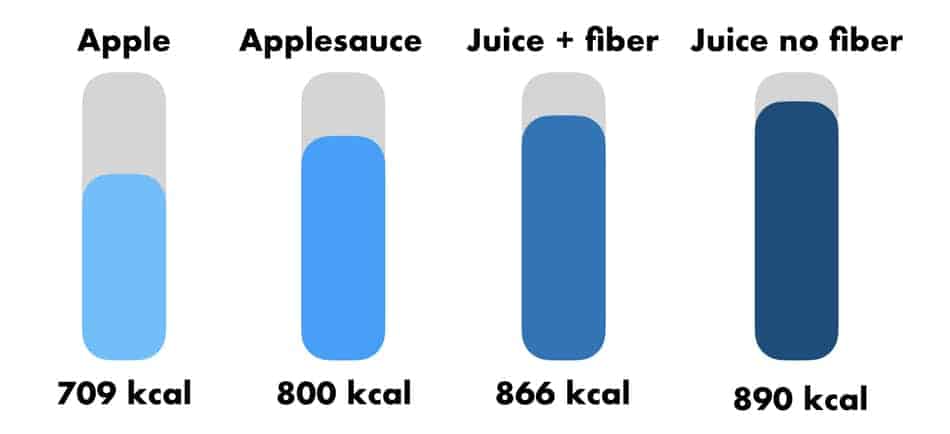
When we look at the satiety score, apples are head-to-head with oranges with a satiety score of 197%. That is way better than foods that are high in proteins like beef or eggs.
5. Oatmeal Will Keep You Fuller For Longer
Oatmeal is one of the most recognizable breakfast dishes worldwide. With its excellent satiety score of 209%, it can offer a huge advantage in curbing hunger for a good portion of the day.
In fact, studies show that oatmeal is qualified as an appetite suppressant (source).
And when we look deeper into more studies, all of the research confirms that high-fiber oatmeal is a strong regulator of satiety.
And because you’re no longer hungry, your total food intake goes down. That’s what you want during the calorie deficit. But what are your thoughts about oatmeal? Do you eat oatmeal on a regular basis?
To be honest, the opinions about oatmeal vary.
I’ve decided to pull up my sleeves and survey a dozen of experienced gyms goers from the popular health club to find out what is their take on oatmeal.
After surveying dozen of people about “would you eat oatmeal every day?”, Here’s the most common answers.
“I like it in my cookies!”
“Too many carbohydrates“
“Oatmeal is a complex carb, healthy n keep u full longer”
“Oatmeal = sugar/carbs”
“I love oatmeal, but I wouldn’t eat only oatmeal”
“No! Not a chance”
“I lived on oatmeal in my poor student days lol”
“I avoid oatmeals.. They are high in carbs”
“Oats are among the healthiest grains on earth”
As you can see, even the experienced trainers can get mixed up with oatmeal.
The only downside of oatmeal is the preparation process. Because it takes time to cook, it may feel like it’s too much of a hassle.
6. Fish Has A Greater Satiety From Rest Of Proteins
Protein in general have a much greater satiety than most of carbohydrates and fats.
Not only they take longer to digest, but also they seem to influence the production of plasma glucagon-like peptide 1 (GLP1) and peptide YY (PYY), which are both responsible for satiety.
Also, proteins increase energy expenditure and ramp up the metabolism.
But are all protein created equal? Is having steak, chicken or fish somehow impact my hunger levels?
In the study done by Anthony M. Uhe from Deakin University in Australia, they compared the effects of chicken, beef, and fish on satiety and hunger.
In conclusion, satiety was greater after the fish meal (source).
That doesn’t mean chicken and beef are somehow not filling. They both are rich source of proteins and therefore, will keep you full. The only distinction is that fish also have omega-3 fatty acids that has been linked with in itself to suppress appetite.
Omega-3 intake modulates postprandial satiety in overweight and obese volunteers during weight loss
Dolores Parra (source)
7. Just 2.5 oz of Beans Can Reduce Hunger Levels
Next on the calorie deficit food list are beans that comes with a whopping 5 grams of fiber per 100 grams.
Satiety is triggered by the GI hormones which respond to specific components of foods like fiber and starch. That’s why fiber has become a popular part of supplements in the health space that offers appetite suppression and therefore, leads to sustained calorie deficit weight loss.
But you don’t need supplements to keep you full. Baked beans can do trick right there for you. They have a satiety score of 168%.
A study done by Elizabeth J Reverri assessed the effect of beans on satiety levels. It showed that simply adding beans into a meal has acute beneficial satiety effects, equivalent to supplements (source).
They also have 6 grams of protein, which in itself has a high satiety actions.
Other Calorie Deficit Foods
Those were the top 7 satisfying foods that will help you stay full for longer. But in case you are wondering who does this list compare to the rest of popular foods, look no futher.
Here are the most common foods and their satiety score. In the list below, each food is linked with a satiety number (percentage related to 100%, which is the equivalent of white bread).
Anything over 100% has higher satiety than white bread.
| Potatoes | 323% |
| Ling fish | 225% |
| Oatmeal | 209% |
| Oranges | 202% |
| Apples | 197% |
| Brown pasta | 188% |
| Beef | 176% |
| Baked beans | 168% |
| Grapes | 162% |
| Whole meal bread | 157% |
| Grain bread | 154% |
| Popcorn | 154% |
| All-Bran | 151% |
| Eggs | 150% |
| Cheese | 146% |
| White rice | 138% |
| Lentils | 133% |
| Brown Rice | 132% |
| Honeysmacks | 132% |
| Crackers | 127% |
| Cookies | 120% |
| White pasta | 119% |
| Bananas | 118% |
Food That Increases Your Appetite (Not Good For A Calorie Deficit)
So if some foods have high satiety, that means there will be foods that will make you want to eat more. Those are the foods that instead of suppressing your appetite, actually increase it. Anything under 100% has lower satiety than white bread.
Here are the most common foods that have low satiety.
| Ice cream | 96% |
| Crisps | 91% |
| Yogurt | 88% |
| Peanuts | 84% |
| Mars candy bar | 70% |
| Doughnuts | 68% |
| Cake | 65% |
| Croissant | 47% |
To make it clear, there is nothing wrong with those foods. It’s just it will be very hard maintain calorie deficit when majority of the diet comes from those foods.
A calorie deficit is all about getting your macros right in a way that your energy expenditure exceeds energy consumption if you choose the right type of foods.
Other Ways To Suppress Appetite On Calorie Deficit
I did a survey of 23 of my clients who are currently on a calorie deficit and I asked them what are your methods to control or lower the hunger pangs. Here are the most common and your best options:
- Netflix/Prime
- Water with pink Himalayan salt
- Coffee
- Eating slowly
- Stay busy
- Tea with coconut oil
- Exercise
- Lower carbs
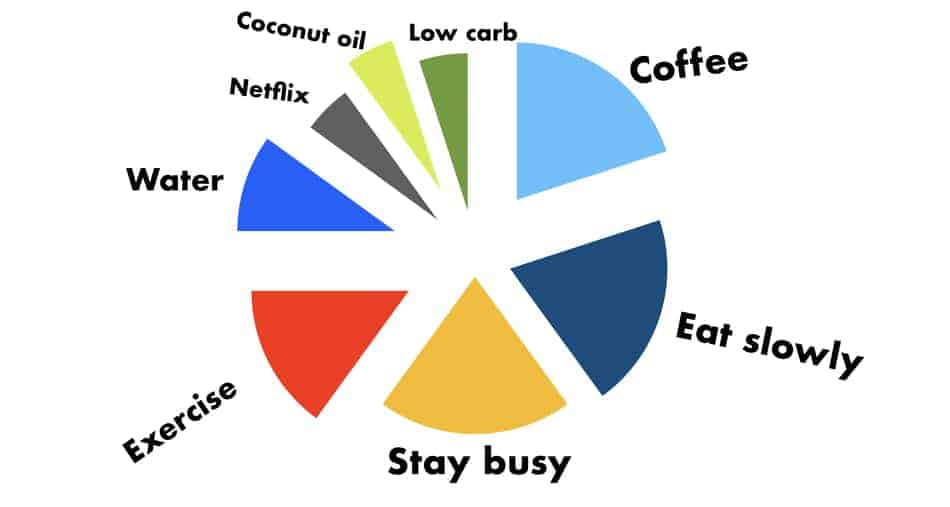
Key Takeaways
In general, calorie deficit foods are all the foods that keep you full the longest. Those are usually
- high satiety
- low-calorie dense foods
- have a significant amount of proteins, dietary fibers, and water
- minimally processed
Which is exactly what you need when you are in a calorie deficit.
To show you how important is food selection while being on a calorie restriction, let me bring up a study done in Mexico (source).
A group of women were given random breakfasts, all divided from lowest in satiety to the highest.
- white bread
- rice and bananas
- whole wheat bread and boiled beans
- fruit salad
Nothing fancy.
But.
3 hours later, everyone was invited to the buffet table where they could eat what they wanted. Here’s what happened.
Despite having breakfast 3 hours earlier, everyone had something.
However, there was a significant difference between the total calories consumed, depending on who ate what for breakfast.
Ladies who consumed:
- white bread ate 872 calories more
- fruit salad ate 461 calories more
Which shows you that having high satiety foods, not only helps to eat less. But also be less hungry for longer. So choosing the foods that keep you full the longest, is a recipe for success.
Conclusion
As a whole, the best calorie deficit foods are foods that create the sensation of fullness in the stomach or absence of hunger. The sensation of fullness is related to physiological factors like diet-induced thermogenesis, sensory-specific satiety, and gut hormones signaling.
In other words, it’s a whole symphony of physiological processes that play together in letting us know whether or not we should stop eating.
- Psychological events and behaviors
- Peripheral physiology
- The central nervous system
Those are the most filling foods that keep you full the longest. Of course, it doesn’t mean that you should only consume them.
However, making smart choices like substitute sweets for oranges or apples, cereals for oatmeal or all bran, adding more potatoes instead of white pasta, feel like not a big commitment, but can make a huge impact on your calorie deficit and how you control hunger.
